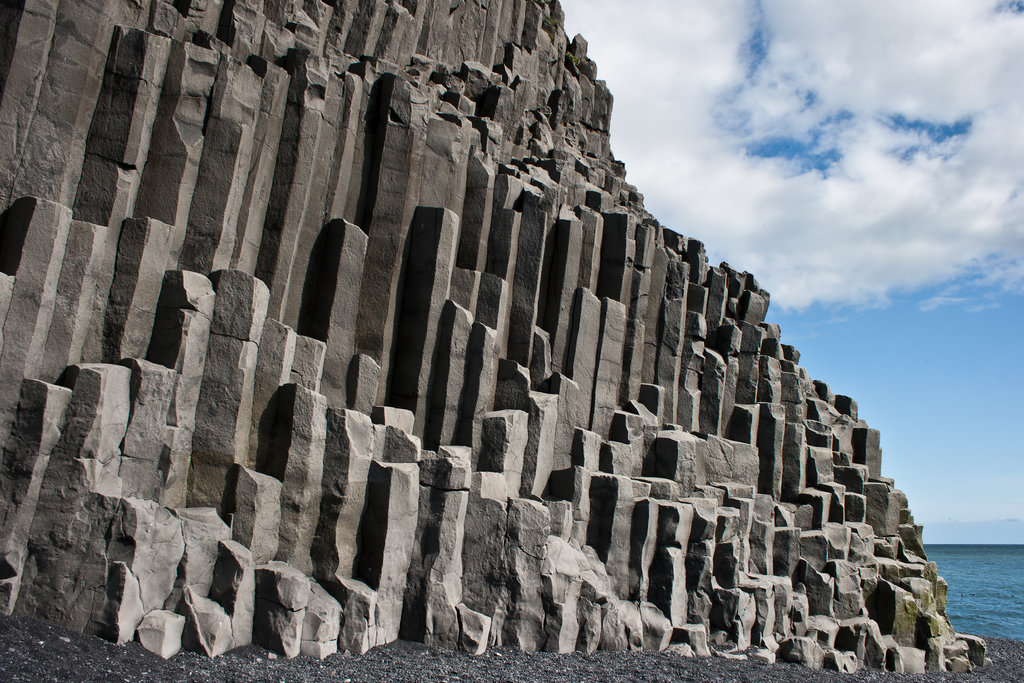Basalt

Basalt is the most common extrusiveRefers to igneous rocks erupted on a planetary body's surface. igneous rockOne of the three basic types of rock that also include sedimentary and metamorphic. Igneous rocks are formed by the solidification of magma and comprised predominately of silicate minerals. Based on bulk chemical analysis, igneous rocks can be grouped into four major groups based on their SiO2 content: 1. Felsic: on the terrestrial planetsRocky planets: Mercury, Venus, Earth, and Mars. These planets have physical characteristics, chemical composition and internal structure similar to the Earth. The terrestrial planets have 0.4% of the total mass of all the planets in the Solar System. Some large satellites of planets are also similar to the characteristics of. For example, more than 90% of all volcanicIgneous rock that forms from cooling magma on the surface of a planet or asteroid. rock on Earth is basalt. The term basalt is applied to most low viscosityThe degree to which a liquid resists flow. High-viscosity liquids (e.g., "molasses in winter") resist flow to a great degree. More formally, viscosity of a fluid is the measure of its resistance to gradual deformation by shear stress or tensile stress. Water has a low kinetic viscosity of 0.6959 dark silicateThe most abundant group of minerals in Earth's crust, the structure of silicates are dominated by the silica tetrahedron, SiO44-, with metal ions occurring between tetrahedra). The mesodesmic bonds of the silicon tetrahedron allow extensive polymerization and silicates are classified according to the amount of linking that occurs between the lavas, regardless of composition.
Basalt is a maficOne of the two broad categories of silicate minerals, the other being felsic, based on its magnesium (Mg) and/or iron (Fe) content. Mafic indicates silicate minerals that are predominantly comprised of Mg and/or Fe.The term is derived from those major constituents: Magnesium + Ferrum (Latin for iron) + ic (having, extrusive and fine grained igneous rock formed from the rapid cooling of magnesium-rich and iron-rich lavaHot molten or semifluid rock derived from a volcano or surface fissure from a differentiated and magmatically active parent body. exposed at or very near the surface of a differentiated parent bodyThe body from which a meteorite or meteoroid was derived prior to its ejection. Some parent bodies were destroyed early in the formation of our Solar System, while others like the asteroid 4-Vesta and Mars are still observable today. such as large asteroids and moons, planetesimalsHypothetical solid celestial body that accumulated during the last stages of accretion. These bodies, from ~1-100 km in size, formed in the early solar system by accretion of dust (rock) and ice (if present) in the central plane of the solar nebula. Most planetesimals accreted to planets, but many –, and planets. Basalts can also form in small intrusiveRefers to igneous rocks that crystallized underground. bodies, such as an igneous dikePlanar, blade-like, intrusive igneous body that cuts across preexisting layers usually at a high-angle to near-vertical orientation. By definition, a dike is always younger than the rocks that contain it. Terrestrial dikes are typically 0.5 to 3 m wide and extend for a few 10s of kilometers. or a thin sill. It is composed of approximately equal amounts of plagioclaseAlso referred to as the plagioclase feldspar series. Plagioclase is a common rock-forming series of feldspar minerals containing a continuous solid solution of calcium and sodium: (Na1-x,Cax)(Alx+1,Si1-x)Si2O8 where x = 0 to 1. The Ca-rich end-member is called anorthite (pure anorthite has formula: CaAl2Si2O8) and the Na-rich end-member is albite feldsparAn alumino-silicate mineral containing a solid solution of calcium, sodium and potassium. Over half the Earth’s crust is composed of feldspars and due to their abundance, feldspars are used in the classification of igneous rocks. A more complete explanation can be found on the feldspar group page. and clinopyroxene, with smaller amounts of other minerals usually including olivineGroup of silicate minerals, (Mg,Fe)2SiO4, with the compositional endpoints of forsterite (Mg2SiO4) and fayalite (Fe2SiO4). Olivine is commonly found in all chondrites within both the matrix and chondrules, achondrites including most primitive achondrites and some evolved achondrites, in pallasites as large yellow-green crystals (brown when terrestrialized), in the silicate portion and magnetiteFe oxide, FeFe2O4, containing oxidized iron (Fe) found in the matrix of carbonaceous chondrites and as diagnostic component in CK chondrites. In CK chondrites, magnetite is typically chromian, containing several wt. % Cr2O3.. Basalt magmaMolten silicate (rock) beneath the surface of a planetary body or moon. When it reaches the surface, magma is called lava. contains less than ~52 wt. % SiO2 (silicaSilicon dioxide, SiO2.).
Due to the rapid cooling of the extruded magma exposed at the surface, large mineralInorganic substance that is (1) naturally occurring (but does not have a biologic or man-made origin) and formed by physical (not biological) forces with a (2) defined chemical composition of limited variation, has a (3) distinctive set of of physical properties including being a solid, and has a (4) homogeneous crystals are unable to form in basalts leading to the fine-grained mineral texture. However, basalts can display a porphyritic texture containing larger crystals (phenocrysts) that formed prior to the final extrusion and are embedded in the fine-grained matrixFine grained primary and silicate-rich material in chondrites that surrounds chondrules, refractory inclusions (like CAIs), breccia clasts and other constituents.. Other textural varieties include glassy, massive, vesicularVesicles appear in nature when they are produced within lava (extrusive aphanitic igneous rock) whose dissolved gases come out of solution (are released) due to the drop in pressure during an eruption. The resulting lava solidifies around the gas bubbles capturing their shape inside and outside the rock. Vesicles do and scoriaceous.






